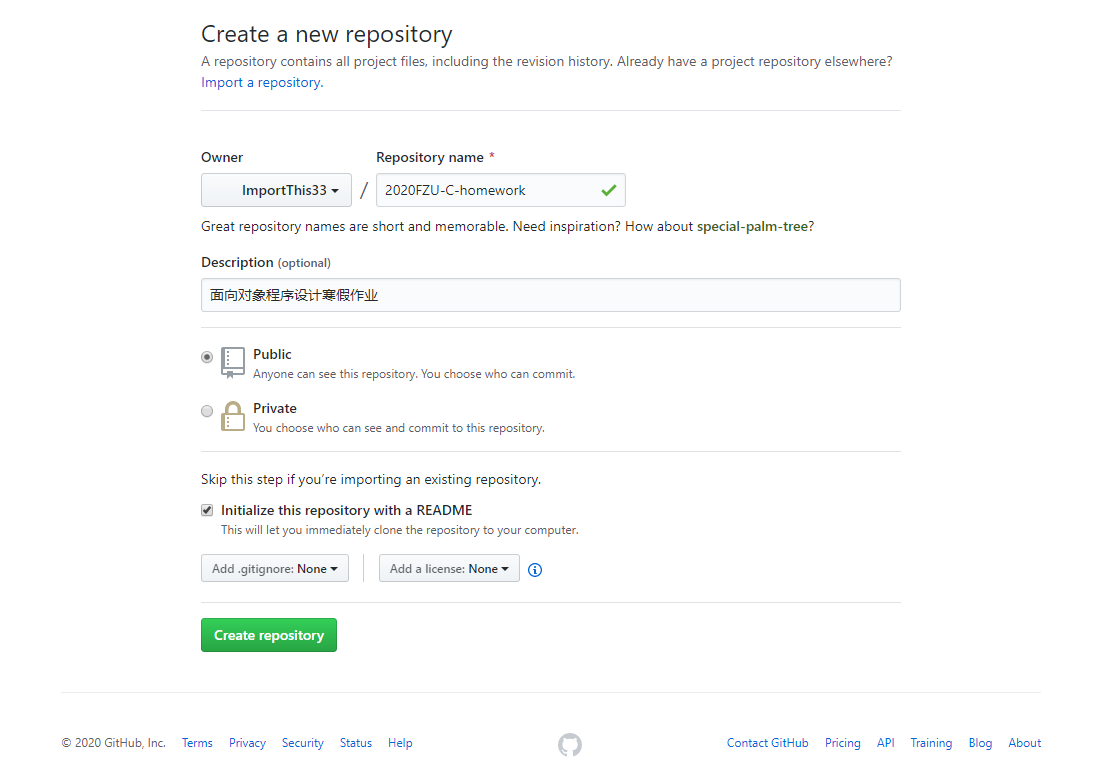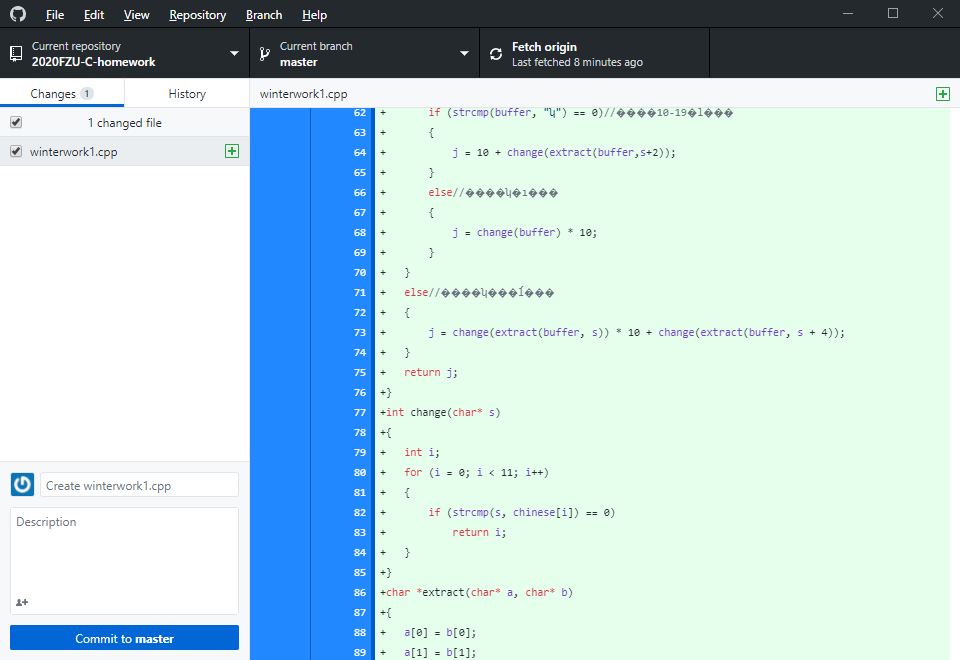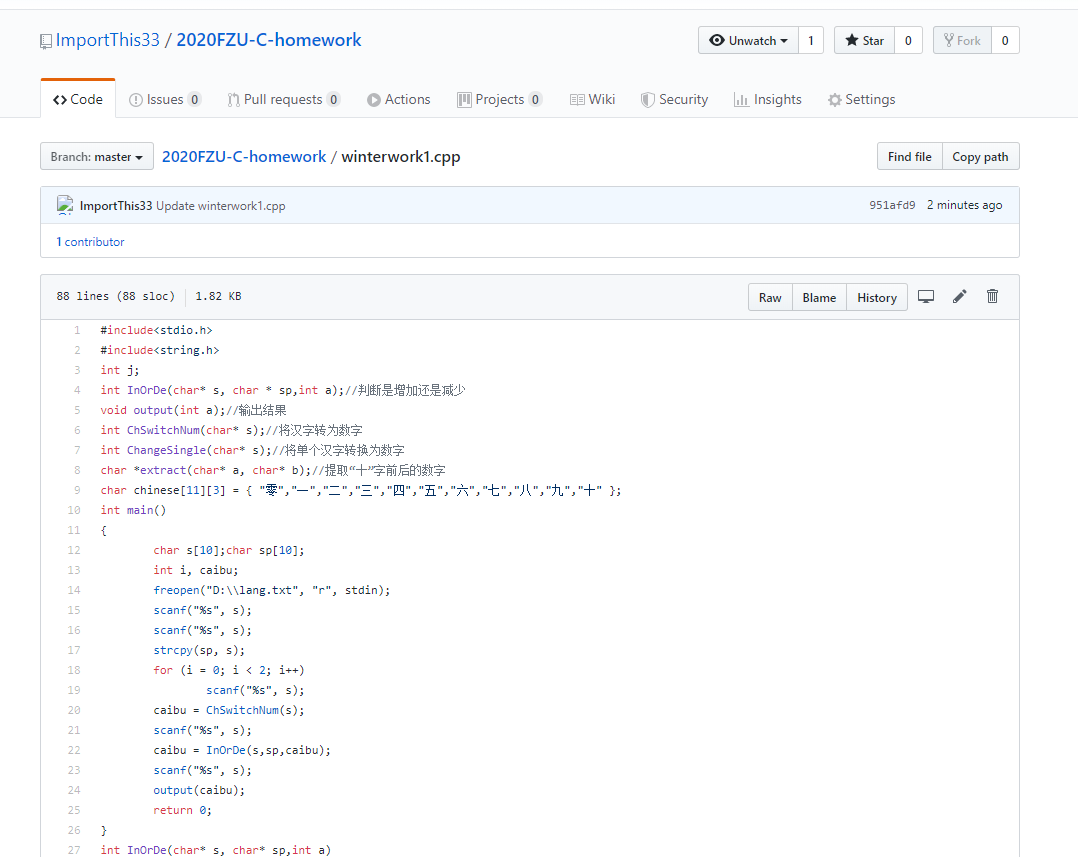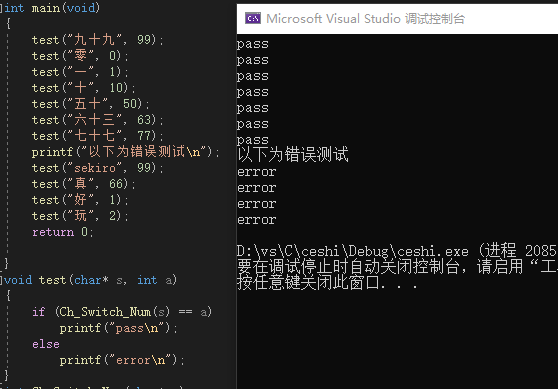面向对象程序设计寒假作业2题解
| 作业描述 | 详情 |
|---|---|
| 这个作业属于哪个课程 | 2020面向对象程序设计 |
| 这个作业要求在哪里 | 面向对象程序设计寒假作业2 |
| 这个作业的目标 | 1.实践题:新建GitHub仓库,并将作业上传至该仓库 2.编程题:优化代码、编译脚本、添加功能 |
| 作业正文 | 面向对象程序设计寒假作业2题解 |
| 其他参考文献 | desktop用法 [power shell的用法](https://www.cnblogs.com/lsdb/p/9531338.html"power shell的用法") Python中os.system的用法 C语言常见命名法 |
一、实践题
新建GitHub仓库


上传编程题代码至仓库


二、编程题
首先是对作业一的编程题进行优化
题目要求:
①优化架构,一般要求每个函数长度不超过15行。
②优化规范,尤其是命名规范。
对于要求①,最先想到的是有没有办法优化一下函数算法,对着代码发了一会儿呆发现这条路太难了,走不通,压到20行左右的时候怎么也挤不出5行
于是想到了函数嵌套套娃,将原本的函数分为更多的函数,更加模块化
对于要求②,参考了骆驼命名法和下划线命名法
除main函数外,共有5个函数
int In_Or_De(char* s, char * sp,int a);//判断是增加还是减少
void output(int a);//输出结果
int Ch_Switch_Num(char* s);//将汉字转为数字
int changeSingle(char* s);//将单个汉字转换为数字
char *extract(char* a, char* b);//提取“十”字前后的数字
Part1.输入
int main()
{
char s[10];char sp[10];
int i, caibu;
scanf("%s", s);
scanf("%s", s);
strcpy(sp, s);
for (i = 0; i < 2; i++)
scanf("%s", s);
caibu = Ch_Switch_Num(s);
scanf("%s", s);
caibu = In_Or_De(s,sp,caibu);
scanf("%s", s);
output(caibu);
return 0;
}
int In_Or_De(char* s, char* sp,int a)
{
while (strcmp(s, sp) == 0)
{
scanf("%s", s);
if (strcmp(s, "增加") == 0)
{
scanf("%s", s);
a += Ch_Switch_Num(s);
}
else if (strcmp(s, "减少") == 0)
{
scanf("%s", s);
a -= Ch_Switch_Num(s);
}
scanf("%s", s);
}
return a;
}
Part.2转换
int Ch_Switch_Num(char* s)
{
char buffer[5] = "";
if (strlen(s) == 2)//处理0-9的汉字
j=changeSingle(s);
else if (strlen(s) == 4)//处理10-19以及十的倍数的汉字
{
strcpy(buffer,extract(buffer, s));
if (strcmp(buffer, "十") == 0)//处理10-19的汉字
j = 10 + changeSingle(extract(buffer,s+2));
else//处理十的倍数
j = changeSingle(buffer) * 10;
}
else//处理几十几的汉字
j = changeSingle(extract(buffer, s)) * 10 + changeSingle(extract(buffer, s + 4));
return j;
}
int changeSingle(char* s)
{
int i;
for (i = 0; i < 11; i++)
{
if (strcmp(s, chinese[i]) == 0)
return i;
}
}
char *extract(char* a, char* b)
{
a[0] = b[0];
a[1] = b[1];
return a;
}
Part3.输出
void output(int a)
{
if (a <= 10)
printf("%s", chinese[a]);
else if (a > 10 && a < 20)
printf("十%s", chinese[a - 10]);
else if (a % 10 == 0)
printf("%s十", chinese[a / 10]);
else
printf("%s十%s", chinese[a / 10], chinese[a % 10]);
}
完整代码
#include<stdio.h>
#include<string.h>
int j;
int In_Or_De(char* s, char * sp,int a);//判断是增加还是减少
void output(int a);//输出结果
int Ch_Switch_Num(char* s);//将汉字转为数字
int changeSingle(char* s);//将单个汉字转换为数字
char *extract(char* a, char* b);//提取“十”字前后的数字
char chinese[11][3] = { "零","一","二","三","四","五","六","七","八","九","十" };
int main()
{
char s[10];char sp[10];
int i, caibu;
scanf("%s", s);
scanf("%s", s);
strcpy(sp, s);
for (i = 0; i < 2; i++)
scanf("%s", s);
caibu = Ch_Switch_Num(s);
scanf("%s", s);
caibu = In_Or_De(s,sp,caibu);
scanf("%s", s);
output(caibu);
return 0;
}
int In_Or_De(char* s, char* sp,int a)
{
while (strcmp(s, sp) == 0)
{
scanf("%s", s);
if (strcmp(s, "增加") == 0)
{
scanf("%s", s);
a += Ch_Switch_Num(s);
}
else if (strcmp(s, "减少") == 0)
{
scanf("%s", s);
a -= Ch_Switch_Num(s);
}
scanf("%s", s);
}
return a;
}
void output(int a)
{
if (a <= 10)
printf("%s", chinese[a]);
else if (a > 10 && a < 20)
printf("十%s", chinese[a - 10]);
else if (a % 10 == 0)
printf("%s十", chinese[a / 10]);
else
printf("%s十%s", chinese[a / 10], chinese[a % 10]);
}
int Ch_Switch_Num(char* s)
{
char buffer[5] = "";
if (strlen(s) == 2)//处理0-9的汉字
j=changeSingle(s);
else if (strlen(s) == 4)//处理10-19以及十的倍数的汉字
{
strcpy(buffer,extract(buffer, s));
if (strcmp(buffer, "十") == 0)//处理10-19的汉字
j = 10 + changeSingle(extract(buffer,s+2));
else//处理十的倍数
j = changeSingle(buffer) * 10;
}
else//处理几十几的汉字
j = changeSingle(extract(buffer, s)) * 10 + changeSingle(extract(buffer, s + 4));
return j;
}
int changeSingle(char* s)
{
int i;
for (i = 0; i < 11; i++)
{
if (strcmp(s, chinese[i]) == 0)
return i;
}
}
char *extract(char* a, char* b)
{
a[0] = b[0];
a[1] = b[1];
return a;
}
制作编译脚本
刚看到这里的时候确实有点被吓退了,完全没有接触过的内容,一点头绪都没有,在查阅了power shell、shell、Windows批处理的相关资料后后还是没有什么头绪
最近正好在自学Python,那天看到一位大佬(感谢)的脚本使用了Python,于是我选择了PythonPython牛逼
引入os模块,调用os.system方法

有exe文件出现,编译成功
单元测试
一开始把问题想的太复杂,问了同学后才知道是自己想太多
所有函数中转换函数Ch_Switch_Num函数最为重要,因此选择她进行测试
测试代码
int main(void)
{
test("九十九", 99);
test("零", 0);
test("一", 1);
test("十", 10);
test("五十", 50);
test("六十三", 63);
test("七十七", 77);
printf("以下为错误测试\n");
test("sekiro", 99);
test("真", 66);
test("好", 1);
test("玩", 2);
return 0;
}
void test(char* s, int a)
{
if (Ch_Switch_Num(s) == a)
printf("pass\n");
else
printf("error\n");
}

添加功能
参考了同学的作业使用了freopen()函数,在代码中添加freopen()便能实现功能的添加






